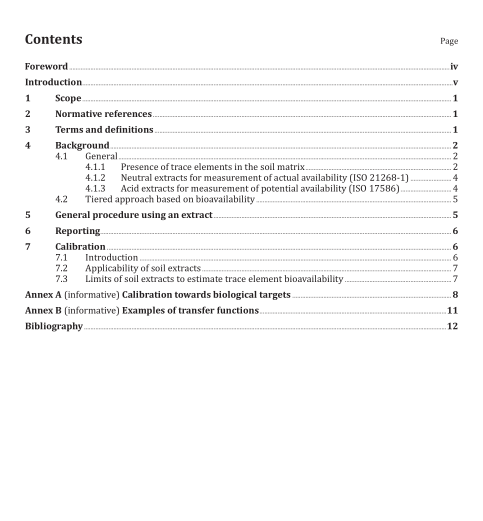ISO 22190:2020 pdf download.Soil quality — Use of extracts for the assessment of bioavailability of trace elements in soils
4.1.2 Neutral extracts for measurement of actual availability (ISO 21268-1) For regulatory purposes simple and cheap methods are required and a simple extraction that simulates the pore water quality is desirable. A neutral aqueous solution (i.e., limiting changes of the soil pH during extraction as much as possible) can be used for this purpose. The concentration of trace element measured in a neutral extract is assumed to reflect the concentration in the pore water [as well as ionic strength, temperature, pH, DOC (Dissolved Organic Carbon)]. These properties may show a variation during the year and can be influenced by external factors (e.g., rain, drought, addition of manure). Extraction of a soil sample with demineralised water may have impact on the soil. For the purpose of estimating the actual availability of trace elements, it is desirable to reduce the influence of external factors and to obtain data that are more independent of the time of sampling. Extraction procedures have been developed using aqueous solutions containing a fixed concentration of a specific salt (neutral extract) in order to simulate the soil pore water.
The stronger the extract (high ionic strength), the higher the amount of trace element released from the soil solid phase. On the other hand, the concentration of extracted DOC is also dependent on the choice of the neutral extract especially the concentration of divalent cations (Ca 2+ ) affects DOC. The ratio soil/ extract also affects the DOC concentration [4] . With a higher amount of DOC extracted, a higher amount of extracted trace elements can be expected, especially trace elements with a high affinity for binding to DOC (e.g. Cu, Pb, Cr). Originally 0,01 mol/l CaCl 2 has been applied as neutral extractant. For several soils this methods reflects the pore water concentration [5][6][7][8] . A concentration of 0,01 mol/l CaCl 2 is often higher than can be measured in the pore water and consequently 0,01 mol/l CaCl 2 can reduce DOC below concentrations in actual pore water, thereby having an effect on the amount of trace elements dissolved [9][10] . In this document, the 0,001 mol/l CaCl 2 extract (ISO 21268-1) is adopted as the currently most suitable soil extraction method, enabling an estimation of trace element concentration in the water phase with a result close to the actual pore water concentration. Results from this extraction can also be used in geochemical modelling of specific bioavailable trace element species in subsequent tiers of the risk assessment, as indicated in 4.2. Although the 0,001 mol/l CaCl 2 extraction is adopted in this document as a general procedure to simulate the pore water concentration of trace elements, other neutral solutions have been shown to be suitable for specific purposes (see Annex A).
NOTE The use of a high salt concentration like 1 mol/l ammonium nitrate [40] as described in ISO 19730 and 0,01 mol/l CaCl 2 has a positive effect on reproducibility and repeatability (see validation of ISO 19730). Results have however a lower truthiness, because high salt concentrations do not simulate the pore water composition.
4.1.3 Acid extracts for measurement of potential availability (ISO 17586)
Strong acids like HNO 3 can be used as an estimate for the potential available fraction. It will be clear that the acid extraction has a very large impact on the composition of the solution. The obtained solution has no relevance anymore to the pore water. A strong acid is a stronger solvent and will give the amount sorbed on the CEC, but also the trace elements in acid soluble salts, which is the amount that comes potentially available. At pH 0,5 the potential available fraction is estimated and this pH is approached with 0,43 mol/l HNO 3 . Non potential available trace elements included in the soil matrix are not extracted at pH 0,5. These are only extracted with a method for the total concentration like aqua regia. The difference between aqua regia and the acid extract are the non-available trace elements and therefore aqua regia is not suitable to estimate the available trace elements.ISO 22190 pdf download.ISO 22190 pdf download
